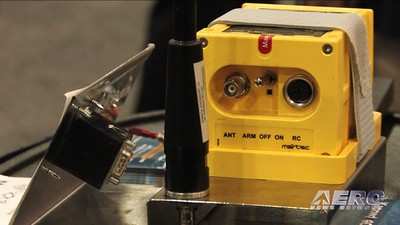Mon, Jun 21, 2010
Implementation Date For The Ban Is Still Not Set In Stone
Effective in August, the FCC is prohibiting further
certification, manufacture, importation, sale or use of 121.5 MHz
emergency locator transmitters. The date of compliance by the FCC
has not yet been announced. AEA, along with other
Associations' leadership, is working with the FAA and the FCC to
postpone implementation and resolve this issue, and AEA says it
will post weekly updates on the website to address this critical
issue.

406 MHz ELT File Photo
In the FCC's Third Report and Order for
2010, adopted June 1, 2010, and published June 15, 2010, the FCC
has prohibited further certification, manufacture, importation,
sale or use of 121.5 MHz ELTs.
Previously, the Cospas-Sarsat satellite system monitored distress
signals on the 121.5 MHz frequency and relayed those signals to
search-and-rescue authorities. As it first announced in October
2000, Cospas-Sarsat stopped monitoring 121.5 MHz signals as of Feb.
1, 2009. It stopped processing distress signals from 121.5 MHz
emergency radio beacons because of accuracy and false-alert
problems. With the support of international aviation and maritime
organizations, Cospas-Sarsat has urged users of 121.5 MHz ELTs and
EPIRBs to switch to 406 MHz ELTs and emergency position indicating
radio beacons.
As the commission noted in the second FNPRM, NOAA, the U.S. Coast
Guard, the U.S. Air Force, and NASA, which jointly administer the
Cospas-Sarsat system in the United States, strongly recommended
users of 121.5 MHz beacons switch to 406 MHz beacons.
After reviewing the comments from the 2006 proposal, the FCC
concluded it should go ahead with the ban.

The AEA was not made aware of this
issue until Monday, June 21st, and has begun working with the FAA,
FCC and other associations to allow for a timely transition to this
new FCC prohibition without grounding thousands of general aviation
aircraft. At this time, the AEA recommends members delay selling
any new 121.5 MHz ELTs until further understanding of this new
prohibition can be understood and a realistic timeline for
transition can be established.
More News
With Testing Soon Complete, Launch Preparations Begin in Earnest Sierra Space's Dream Chaser has been put through the wringer at NASA's Glenn Armstrong Test Facility in Ohio, but w>[...]
Takeoff Roll The process whereby an aircraft is aligned with the runway centerline and the aircraft is moving with the intent to take off. For helicopters, this pertains to the act>[...]
“We’re proud of the hard work that went into receiving this validation, and it will be a welcome relief to our customers in the European Union. We couldn’t be mor>[...]
"Aircraft Spruce is pleased to announce the acquisition of the parts distribution operations of Wag-Aero. Wag-Aero was founded in the 1960’s by Dick and Bobbie Wagner in the >[...]
IDENT Feature The special feature in the Air Traffic Control Radar Beacon System (ATCRBS) equipment. It is used to immediately distinguish one displayed beacon target from other be>[...]
 Sierra Space Repositions Dream Chaser for First Mission
Sierra Space Repositions Dream Chaser for First Mission ANN's Daily Aero-Term (05.10.24): Takeoff Roll
ANN's Daily Aero-Term (05.10.24): Takeoff Roll Aero-News: Quote of the Day (05.10.24)
Aero-News: Quote of the Day (05.10.24) Aero-News: Quote of the Day (05.11.24)
Aero-News: Quote of the Day (05.11.24) ANN's Daily Aero-Term (05.11.24): IDENT Feature
ANN's Daily Aero-Term (05.11.24): IDENT Feature




